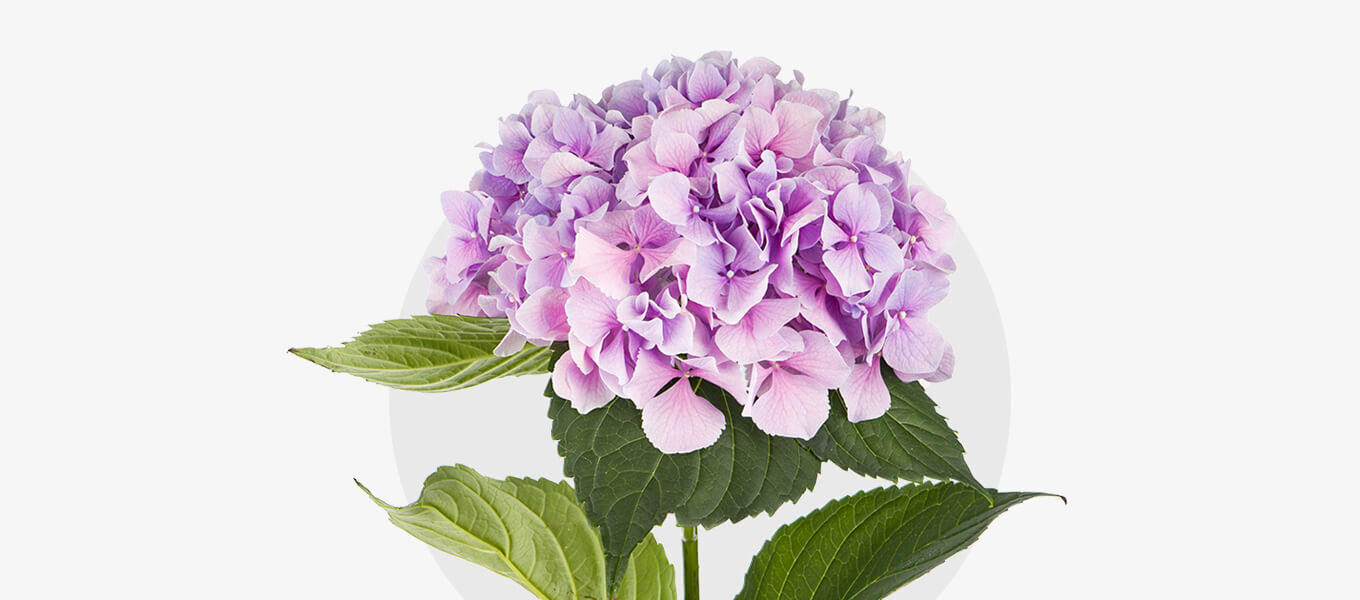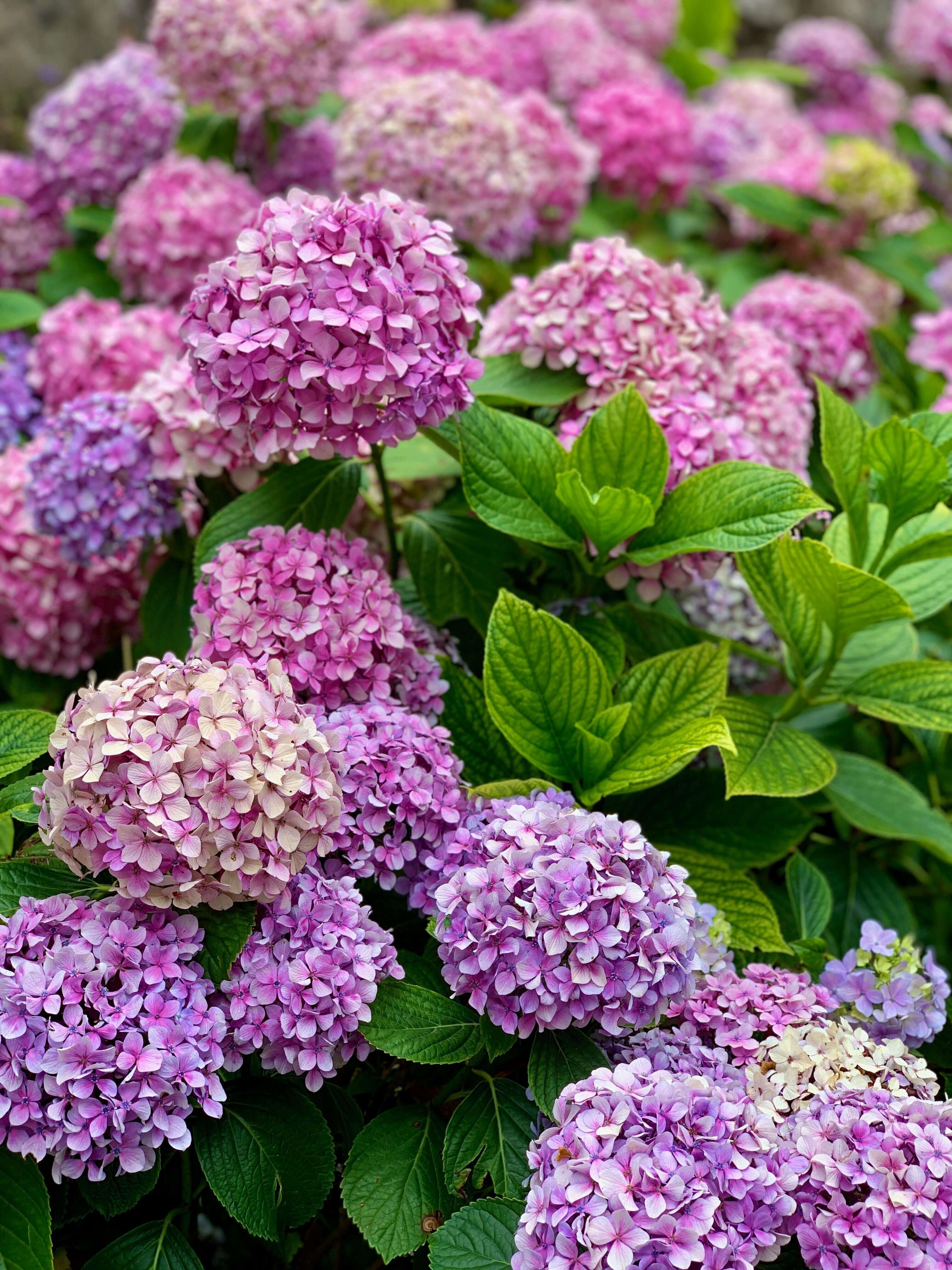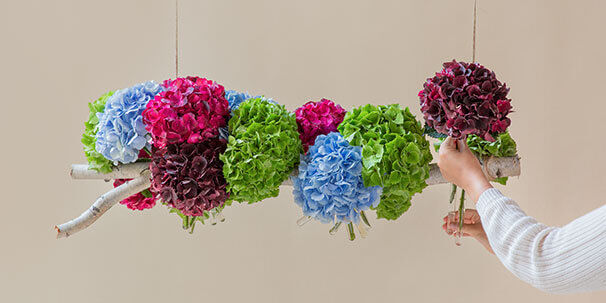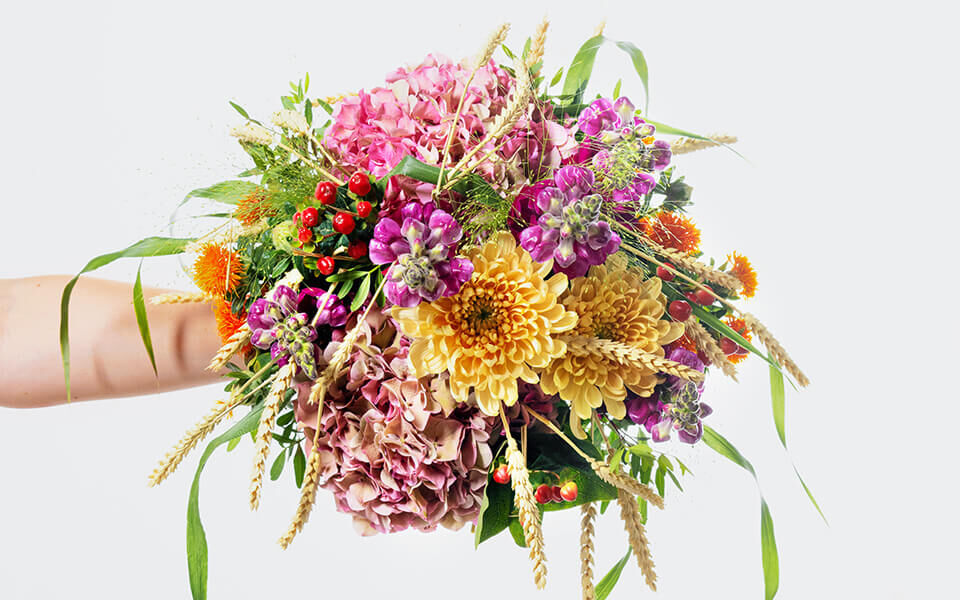Hortensias

Hydrangea has become one of the most popular cut flowers as well as garden and container plants. The enormous breeding efforts of specialist gardeners have produced varieties with magnificent flower balls in many colours. Here we present the hydrangea and its various species.
The hydrangea's botanical name Hydrangea refers to its love of water - hydrangeas need a lot of water. The name of the best-known species in our gardens, the ball or farmer's hydrangea Hydrangea macrophylla, also refers to its large flowers. Hydrangeas do indeed delight with their large, decorative inflorescences. Botanically, they are umbels with many individual flowers and come in many different colours.
The origin of hydrangeas
The Ball hydrangea is native to Japan. The moist air of cool mountain regions there allows them to grow into lush semi-shrubs. For our garden and park plants, this also means that they thrive best in nutrient-rich, moist soil in a semi-shady, airy spot. Other species also originate from the mountainous regions of East Asia, especially China and Taiwan.
Hydrangea species
Hydrangeas come in many species and varieties. The best known is the aforementioned ball hydrangea or farmer's hydrangea H. macrophylla. Its flower balls, which can reach the size of a honeydew melon, are also a delight in autumn bouquets and adorn individual flowers that change colour as they mature. It is extremely popular as a dried flower and is used in a variety of floristry applications.
The panicle hydrangea H. paniculata is a robust, absolutely frost-hardy sister of the farmer's hydrangea and a popular ornamental shrub for gardens, growing up to four metres high. Its speciality: the mostly creamy white flower panicles are cone-shaped. They also adorn the vase or shrub as dried flowers from late autumn onwards.
As the name suggests, the plate or mountain hydrangea H. serrata has rather flatter and plate-shaped flower panicles. They are usually bicoloured. The outer edge with the sterile false flowers is more colourful. These attract insects. The centre consists of the fertile, but significantly smaller and less conspicuous flowers with coloured stamens. Plate hydrangeas are popular container plants and thrive magnificently in a sunny location with a good supply of nutrients and water.
Unlike its relatives, the climbing hydrangea H. petiolaris is a true climbing artist. It conquers walls or trellises and is a special ornament in the garden thanks to its uncomplicated care and winter hardiness. It is helped by the adhesive roots that it forms on the side of its shoots facing away from the light and which grow into stronger branches.
The velvet hydrangea or rough hydrangea H. aspera ssp. Sargentiana has, similar to the plate hydrangea, flatter and bicoloured inflorescences. Its velvety, hairy, elongated leaves give it its name. The bush can grow up to 2.5 metres high. Unlike the other species, the velvet hydrangea does not change colour in autumn, as its leaves fall off before they turn green.

Appearance and flowering time of hydrangeas
The imposing, eye-catching and large flowers of hydrangeas are, in the botanical sense, umbels with many individual flowers. These small individual flowers, which can grow up to 3 cm in size, usually have four petals. As a rule, the ball- or disc-shaped flowers develop from June. Newer cultivars flower as early as May and can continue to produce inflorescences until October.
There is an interesting speciality of some varieties of the ball hydrangea. Whether they flower blue or pink depends on the mineral alum. If this is found in the soil or if the plant is watered with it, its petals turn blue. When the amount of the aluminium salt alum decreases, the flower colour changes back to pink. However, other conditions must also be right for this discolouration process. An acidic soil with a pH value of less than 5.5 is necessary, as are temperature and humidity. Alum is available from garden centres and pharmacies. The hydrangeas must be watered with it up to six times a week from May onwards. But be careful: the tap water must not be too calcareous, as this would have a counterproductive effect!
When hydrangeas start to flower and how long the magnificent heads can be admired and enjoyed depends on the variety, the care and the site conditions. Under the right conditions, hydrangeas will present their flowers for months. Early varieties begin to open their flower buds, which were already laid the previous year, as early as May. These include, for example, the climbing hydrangea or the velvet hydrangea. However, the main flowering period falls in the summer. Most varieties continue to flower into September, with some even making it into October.
In keeping with its name, the Endless Summer hydrangea blooms well into autumn. More precisely, until October. It is a farmer's hydrangea and has been bred to produce new flower shoots on cut shoots within six weeks. There is now a whole collection of so-called Endless Summer hydrangeas available on the market, all of which are characterised by exceptional winter hardiness and a flowering period that lasts throughout the summer and into the autumn.
Hydrangea location and the right soil
Hydrangeas generally need a semi-shady location. Sunny spots should be avoided at all costs. The soil should be fresh, rich in humus and low in lime. Special rhododendron soil is ideal if this is also added to the generously dug planting hole.
If the hydrangea is planted in a container, this should be twice as large as the root ball. The container should have a drainage hole and should also be placed in a semi-shaded and wind-protected location. After planting, the root ball must be well watered with plenty of water. Hydrangeas must never be allowed to dry out; they need constant moisture and therefore regular watering.
Hydrangeas are considered shade plants, but some species also thrive in sunny locations. The prerequisite for this is rich soil and regular watering. Hydrangeas that tolerate sun include the opulent snowball hydrangea, the panicle hydrangea and the unusual oakleaf hydrangea with its blood-red autumn foliage.
The magnificent hydrangea heads come in different colours. However, blue and pink varieties can also change their flower colour due to the soil conditions. This is due to the pH value of the soil. The flowers of farmer's or garden hydrangeas contain the pigment delphinidin, the colour of which depends on the pH value of the soil. The more acidic the soil, i.e. the lower the pH value (4 to 4.5), the more blue the plants will flower. At higher values, the flower colour changes from pink to red. White hydrangeas usually remain white, but can change colour to green. The reasons for this vary. On the one hand, a greenish colouration is a natural process during flowering and flowering, but it is also an indication of incorrect care, such as insufficiently acidic soil, too little water and excessive heat.
Planting hydrangeas
The best time to plant is from March to the beginning of June. If there is a risk of late night frosts in spring until the ice saints in May, the plant should be covered with a fleece to protect it. Hydrangeas can also be planted out later because they are now containerised. However, this should not be done later than August. Otherwise there is a risk that the plants will not grow well enough and the winter temperatures could damage them.
If you want to propagate hydrangeas yourself, you can do this by taking cuttings in early summer. A 5 to 7 cm long shoot with a pair of leaves is inserted into moist, humus-rich propagation soil. To prevent excessive evaporation via the leaves, these are shortened to a third. It is best to place a perforated plastic bag over the cuttings to increase the humidity around the cuttings and favour rooting. This happens after approx. 3 weeks. The rooted cuttings can then be transplanted individually into slightly larger pots.
Care tips for hydrangeas
The flowers form at the end of the woody shoots. Many garden owners are therefore unsure how and when they should prune their hydrangea bushes. To avoid cutting off flower buds that have already set, only old flowers and frozen shoots above the next bud below should be pruned in early spring to early March. If you are unsure whether a shoot is frozen, scratch the bark a little with your fingernail. If it is soft and greenish tissue appears underneath, the shoot is still healthy and will sprout again. As a rule, faded shoots should only be cut in spring, as this protects the buds underneath for longer. Exceptions are the remontant, i.e. re-flowering Endless hydrangeas. With these, you should reach for the secateurs immediately after the first flower has faded. If you remove the faded flowers, they will flower again in the course of the summer.
Pruning should also be carried out if the shrubs have grown together very densely. Individual old shoots should then be cut out from the ground up.
The hydrangea's botanical name Hydrangea is the first indication that the plant needs plenty of water. On hot summer days, it is advisable to water the hydrangea daily. If it is in a container, it may even be necessary to water twice a day. The amount of watering is slowly reduced towards autumn, but hydrangeas also need regular watering in winter, otherwise they will dry out in their winter quarters.
Hydrangeas belong to the rhododendron family, they need acidic soil and rather little lime. Humus-rich, evenly moist soil is best, which can be enriched with a little manure in spring. If you don't have manure - and preferably cattle manure - available, you can use dried pellets from a specialist shop. Shortly after budding and in June/July, commercial hydrangea fertiliser should be added to the irrigation water, and one last time at the end of July. Freshly planted hydrangeas do not need any fertiliser in their first year.
Hydrangeas in containers should be fed with hydrangea liquid fertiliser every fortnight according to the instructions on the packet. In principle, the plant should never come into direct contact with the fertiliser, but it should be worked into the pre-moistened soil around the plant.
As hydrangeas prefer an acidic soil, only a special hydrangea fertiliser is suitable. This lowers the pH value of the soil to adapt it to the needs of the plant. Hydrangeas need a fertiliser that is high in nitrogen but low in phosphorus. Universal fertilisers are therefore not suitable for hydrangeas as they usually contain a large amount of phosphorus. It is precisely this that does not suit the plants.
Hydrangeas can be fertilised from March to August. Fertilisation should be discontinued in late summer, otherwise there is a risk that the shoots will become very soft and sensitive to frost.
Well-established hydrangea plants in the garden that are in a sheltered, i.e. unexposed location, generally do not need winter protection, except in very cool and frost-prone altitudes. Younger and smaller plants should be protected at the roots with a thick layer of autumn leaves. Wrapping the plants with jute sacks, fleece or other air-permeable textiles will also protect them.
Hydrangeas as potted plants on balconies and terraces need winter protection. Either they are overwintered in a cool, frost-free, unheated place, such as a shed, cellar or cool stairwell. To do this, you should remove brown leaves and dead plant parts when you bring them in so that they do not provide an attack surface for fungi and bacteria. You can also wrap their pots with jute sacks, fleece, coconut mats or other air-permeable textiles. Bubble wrap is also often recommended. This harbours the risk of moisture accumulating underneath and preventing air exchange. The air underneath could also heat up quickly with the first warming ray of sunshine and thus damage the plants. We therefore advise against this.
The hydrangea likes a slightly acidic and low-lime substrate; azalea or rhododendron soil is best suited.
There can be various reasons why a hydrangea does not flower: The hydrangea has been pruned incorrectly, is in too shady a location, has poorly suited soil or has frozen in a late frost. Hydrangeas with their magnificent heads are beautiful, but very demanding. With this guide to correct care and planting, you can find out why your hydrangea is not flowering and solve the problem.
The best planting partners should feel at home in the hydrangea's location. Shade-loving perennials are particularly suitable here. In addition to the large, magnificent hydrangea flower heads, more discreet planting partners with a more restrained colour spectrum blend in well. However, this is a question of taste and those who still like bold colour combinations with the visually dominant colours of hydrangeas can let off steam in the flower bed. However, there is another important point to bear in mind when choosing plants: The other planting partners should not be in a water battle with the hydrangea. All hydrangeas react very sensitively to a lack of water. The choice should therefore not be made in favour of a highly competitive species.

Can hydrangeas be dried?
Hydrangeas enchant the summer with their magnificent balls of flowers. To prolong their flowering period, hydrangeas can simply be dried as cut flowers. The easiest way to do this is to leave the hydrangeas to dry in a vase with a little water. If they are placed in a mixture of water and glycerine (in a ratio of 2:1) instead of pure water, the flowers will retain their colour. However, the classic drying technique of hanging the inflorescences upside down in an airy, dark place also works for hydrangeas.
Proper care of hydrangeas in the vase
To ensure that the woody stems of hydrangeas can quickly absorb fresh water as a cut flower in a vase, they are cut at an angle with a long cut. They should then be immediately placed in fresh water so that no air can penetrate. The water in the vase should be fresh and lukewarm. Water that is too cold is less well absorbed. Some experts recommend immersing the stems in boiling hot water for two seconds after cutting and then immediately in cold water. A preservative can also be added to the vase water. Otherwise, the vase water should be changed daily. However, it is important that no leaves come into contact with the vase water. The lower leaves should be removed anyway. Upper leaves can also be removed as the plant needs to supply them with additional water.
Hydrangeas should be sufficiently mature for a vase life. Gardeners and florists pay attention to this when harvesting so that customers can enjoy the flower stems for a long time. Anyone cutting hydrangeas in their own garden to put them in a vase should also pay attention to this. Flowers are mature when they rustle slightly when touched and feel rather dry and parchment-like.
Some hydrangeas will keep for a long time in the vase and can even be used in dried containers afterwards. Wrapping wreath blanks in particular with the thick flower balls of hydrangeas in autumnal iridescent colours is not only quick and easy to do, but also a beautiful and long-lasting decoration idea.
If the above tips are followed, hydrangeas will last for several weeks in the vase instead of just a few days. Proper care is also noticeable when they dry out later, when the flowers are still juicy and their heads are not drooping. The dried hydrangea will last for a long time in the vase.
Cuttings are required for the propagation of hydrangeas. To do this, cut cuttings of a hydrangea about ten centimetres long with a clean, sharp knife. The cuttings should not have any buds and should be a bright green colour. Cut off all but one pair of leaves. These leaves are split down the centre, leaving two half leaves. A glass of water can be the perfect environment for a cutting, as an alternative to a seed tray. Each cutting is placed in a glass of low-lime water. The water must be changed daily. Tender roots should soon appear and the cutting can be moved to a flower pot after a while.

















